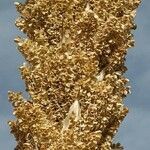An evergreen tree. The trunk is un-branched and 1.5-3 m tall. The leaves are blue-green and very spiny. The leaves are 1 m long. They radiate out in a circle. The flower spike is very tall. It can be 4.5 m tall. The flowers are very small and cream. The fruit are brown nuts.




